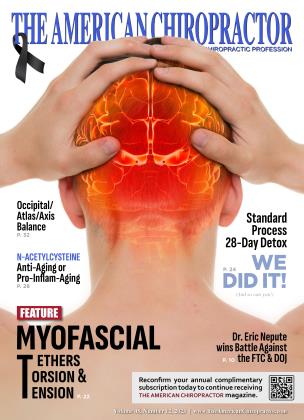Blood Sugar Migraines An Alternative Approach
IN BRIEF
NUTRITION
Stephan Ediss
DC
Food industries have inundated the public with so many processed food choices in the name of “convenience.” As consumption of these products increases, so does the rate of diabetes, insulin resistance, obesity, hypertension, arteriosclerosis, inflammation, polyarthralgia, and fibromyalgia, to name a few. Couple this with conflicting diet theories and health advice from magazines and the Internet, our patients are contused and looking for guidance, and so are their body chemistries.
Vacillating blood sugar can cause a myriad of symptoms. For the purpose of this article, the focus will be on migraine headaches in relationship to hyperglycemia and hypoglycemia. Providing guidance for your individual patient’s needs and a very simple chiropractic manipulation technique can be very effective in reducing the frequency and severity of a “blood sugar headache.”
A contributing factor that can lead to significant nervous system and vascular damage is glycosylation. This oxidative process takes place when sugars bind to proteins. By not allowing blood sugar to get out of control thr ough proper diet, exercise, and supplementation, we can minimize the damage done by glycosylation. We can guide patients to control their blood sugar in natural ways without having to suffer the side effects caused by some prescription medications.
In my experience, timely feedings are very important, whether for hyperglycemia or hypoglycemia. For these patients, playing with certain diets can exacerbate their blood sugar handling issues. I am partial to a balanced paleolithic diet, or a Mediterranean diet, loaded with flesh produce, proteins, and fats and minimizing to eliminating processed foods and flans fats. An ample amount of clean water is important because many patients think that any liquid counts when it comes to hydrating.
Keeping the glycemic index of food choices low has been found to be beneficial when reestablishing the function of insulin and how our cells respond to it, specifically in insulin resistance. For example, a raw carrot has a glycemic index of 40, but when cooked, the glycemic index jumps to 80. When patients take their time eating, chew well, and even occasionally blend produce, the risk of irritating the intestinal lining is reduced.
When choosing nutritional support, recent human trials note that benfotiamine supplementation may be beneficial as support for glucose metabolism, glycosylation, and oxidative stress. (Gibson GE, et al. 2020). Additionally, researchers from Biomedicine & Pharmacotherapy (2018) reported evidence indicates supplementation with carnitine, CoQlO, niacin, vitamin B12, and alpha lipoic acid can be helpful for migraines.
Exercise recommendations do not need to be difficult, but they do need to be consistent, within the patient’s capabilities, include resistance training, stretching, and challenge the cardiovascular system. Twenty to 30 minutes of elevated heart rate four to five times per week is effective and allows the body to recover and repair on days off. Resistance training should focus on range-ofmotion exercises using enough resistance to challenge the muscles without injuring the joints. My personal preference is using your body weight for resistance with anchored straps and bungee resistance training.
Once dietary recommendations, supplementation, and exercise have been addressed for the patient, you can turn your attention to the patient’s structure. I have found a C5 reflex adjustment to be very effective, particularly for those suffering from hypoglycemia.
Upon completion of all necessary chiropractic manipulative treatment, have the patient to get into a supine position. Flex the right hip and knee, placing the patient’s right foot flat on the table. With a straight left leg resting on the table, instruct the patient to dorsiflex their left foot and lock their knee straight. Raise the straight leg with their toes toward their nose until it is parallel to the right femur. Muscle test the straight leg; testing weak indicates low blood sugar (left is low blood sugar). Using the same procedure on the opposite side, with the left hip and knee flexed and right leg straight with toes toward the nose; a weak straight leg muscle test indicates hyperglycemia (right is high blood sugar).
The correction is simple. In the first example, with the left leg straight and toes toward the nose, instruct the patient to raise the straight leg up. As the left femur approaches (parallel) the right femur, the doctor administers a lateral to medial thrust on C5 opposite (on the right) the straight leg (left). Perform the original weak straight leg raise test (looking for strength) to ensure that the C5 reflex has been reset. Typically, patients experience a rapid-to-innnediate reduction in their migraine symptomatology.
Stephan P. Ediss, DC, PAK, FIACA, has over 300 hours of certified training as a professional applied kinesiologist and has been in practice for 31 years. All his knowledge is compiled in an organized, easy-to-follow, step-by-step protocol resulting in amazing clinical outcomes. Call him at 307-358-3147 or email at [email protected].
 View Full Issue
View Full Issue






